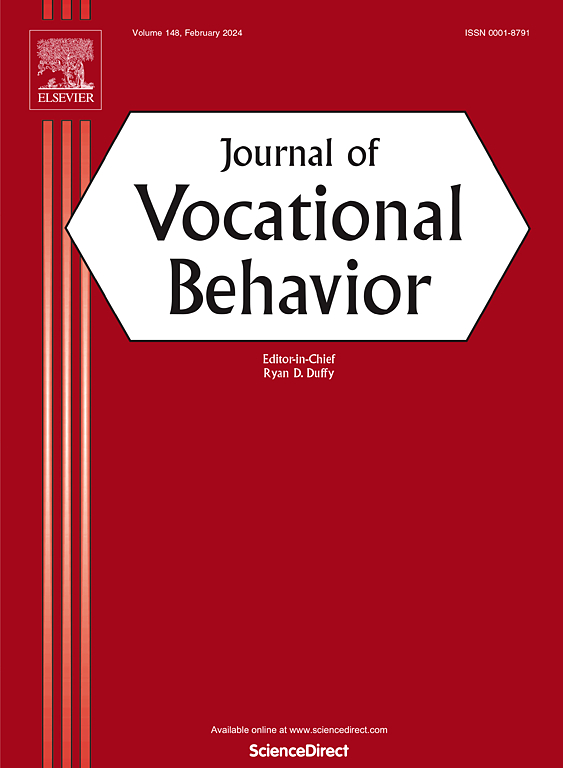Employees' affective commitment to multiple work-related targets: A longitudinal person-centered investigation
IF 5.2
1区 心理学
Q1 PSYCHOLOGY, APPLIED
引用次数: 0
Abstract
This study uses a person-centered approach to investigate the structure, stability, antecedents, and outcomes of employees' affective commitment to multiple work-related targets. Following Perreira et al.'s (2018) hierarchical representation of commitment, profiles of affective commitment were estimated by considering both global levels of commitment to the work life and specific levels of commitment to organization, supervisor, coworkers, occupation, work, and career. To this end, a sample of 468 individuals working in firefighting stations located in France was surveyed twice over a four-month period. Our results revealed six commitment profiles: (1) Globally Moderately Committed with a Hierarchical-Organizational Orientation, (2) Globally Weakly Committed with a Balanced Orientation, (3) Globally Strongly Committed with an Occupational Orientation, (4) Globally Moderately Committed with a Hierarchical-Supervisor Orientation, (5) Globally Strongly Committed with a Career Orientation, and (6) Globally Strongly Committed with a Social Orientation. Over time, these profiles displayed a high level of within-sample and within-person stability. Global levels of authentic leadership were related to a higher likelihood of membership into profiles displaying higher global levels of commitment (especially those with a social or occupational orientation) than into the other profiles. Levels of perceived health, work efficiency, improvement-oriented behaviors, and job satisfaction also differed across profiles, with some of the worst outcomes found in the Globally Moderately Committed with a Hierarchical-Organizational Orientation profile.
员工对多重工作目标的情感承诺:一项以人为本的纵向调查
本研究以人为本,探讨员工对多重工作目标的情感性承诺的结构、稳定性、前因和结果。根据Perreira等人(2018)的承诺层次表示,通过考虑对工作生活的整体承诺水平和对组织、主管、同事、职业、工作和职业的具体承诺水平,对情感承诺的概况进行了估计。为此,在法国消防站工作的468人在四个月的时间里接受了两次调查。我们的研究结果揭示了六种承诺特征:(1)全球中等承诺,层级组织导向;(2)全球弱承诺,平衡导向;(3)全球强承诺,职业导向;(4)全球中等承诺,层级主管导向;(5)全球强承诺,职业导向;(6)全球强承诺,社会导向。随着时间的推移,这些特征显示出高水平的样本内和个人内稳定性。真实领导的全球水平与更有可能加入具有更高全球承诺水平的概况(特别是那些具有社会或职业取向的概况)相关,而不是其他概况。感知健康、工作效率、以改进为导向的行为和工作满意度的水平在不同的人群中也有所不同,其中一些最差的结果出现在具有等级组织导向的全球适度承诺人群中。
本文章由计算机程序翻译,如有差异,请以英文原文为准。
求助全文
约1分钟内获得全文
求助全文
来源期刊

Journal of Vocational Behavior
PSYCHOLOGY, APPLIED-
CiteScore
13.10
自引率
5.40%
发文量
85
期刊介绍:
The Journal of Vocational Behavior publishes original empirical and theoretical articles offering unique insights into the realms of career choice, career development, and work adjustment across the lifespan. These contributions are not only valuable for academic exploration but also find applications in counseling and career development programs across diverse sectors such as colleges, universities, business, industry, government, and the military.
The primary focus of the journal centers on individual decision-making regarding work and careers, prioritizing investigations into personal career choices rather than organizational or employer-level variables. Example topics encompass a broad range, from initial career choices (e.g., choice of major, initial work or organization selection, organizational attraction) to the development of a career, work transitions, work-family management, and attitudes within the workplace (such as work commitment, multiple role management, and turnover).
 求助内容:
求助内容: 应助结果提醒方式:
应助结果提醒方式:


